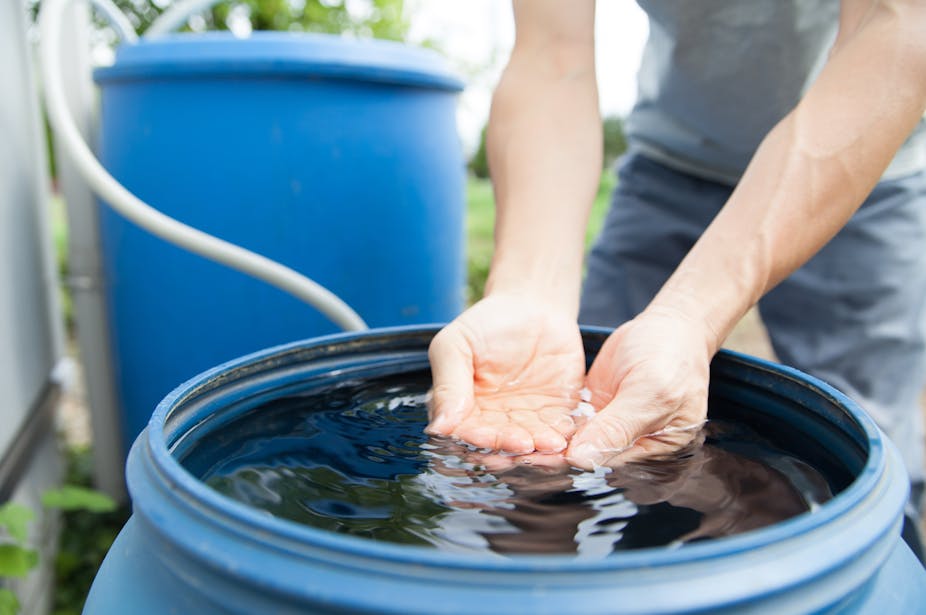Earlier this year, southern England experienced its driest July on record. The drought affected many parts of the UK and grew so acute that Thames Water’s hosepipe ban will remain in force into 2023.
But rainfall in August was heavy. The volume of rain caused outdated drainage and sewerage systems to overflow, degrading the quality of many of the UK’s rivers.
Extreme weather patterns such as these are set to dominate our future. The Environment Agency predicts that demand for water in southern England may outstrip supply in the next 20 years. Yet, at the same time, as many as 5.2 million UK properties are threatened by flooding.
Our research suggests that collecting rainwater in water butts may offer a solution to these problems. This cheap, small-scale intervention could help protect households against water risks while engaging those involved with water issues. Unfortunately, the government tends to ignore this scale of intervention.
Engineered solutions to water issues
Water management in England is largely isolated to large infrastructure projects. Reservoirs are built to withstand drought and larger sewers are seen as the solution to flooding and water pollution.
But these approaches are costly; Central London’s new sewer, the Thames Tideway Tunnel, will cost £4.3 billion.
They can also harm the environment. The Thames Tideway tunnel will prolong the energy-intensive pumping of dirty sewage, while building reservoirs often involves the flooding of agricultural land and wildlife habitats.
These government and water industry solutions also fail to engage the public. Public awareness of the dual drought and flood crises, therefore, remains low. According to a report published in 2020 and partly funded by the Environment Agency, 72% of people surveyed believe that the UK has enough water to meet the country’s needs.

Re-thinking water management
There are other ways to manage the UK’s water better.
The roof area of an average terraced house in the UK (30m²) receives 19,000–55,000 litres of rain each year. Our modelling suggests that a significant proportion of household water consumption could be met by collecting this water.
Averaged across the UK, we found that a 210-litre rain tank – equivalent to a small bath – could supply 15% of a household’s total annual water consumption. But this will be subject to clear geographic and seasonal variation.
The calculation accounts for the loss of rainwater through processes such as evaporation. Current regulations also restrict the use of rain tank water to non-potable demands, such as flushing toilets.

In the wetter northwest of Scotland, we found that 26% of a household’s annual water consumption could be met by collecting rainwater. In contrast, only 9% could be supplied in the southeast of England, dropping to 4% in the driest months. Although this seems a low value, it still equates to 14 litres of water per household each day.
Reducing the risk of flooding and pollution
In the future, wetter winters will also become more common. This will amplify the risk of flooding and water pollution. Our research suggests that a network of small water butts fitted across towns or cities could substantially reduce these risks.
In the event of a storm, a 210-litre water butt can capture 7mm of rainfall from the roof of an average terraced house. To put this in context, in the English city of Hull, a storm that deposits 22.3 mm of rainfall is sufficient to cause flooding. This amount of rain typically falls once every ten years.
So if we can store 7mm of that rain in a water butt, then the amount that is required to cause a flood rises to 28.6mm. A storm that results in this amount of rainfall only occurs once every 30 years.

This approach is not without its limitations. The area that is occupied by roofs is far smaller than the total area over which rain falls. The hydrology of a flood is also complex, including the movement of water through a catchment from uplands to lower-lying areas.
But if used in combination with sustainable drainage systems and other natural flood management measures, water butts could make a small but meaningful contribution to reducing the threat of flooding and water pollution. Through various processes, sustainable drainage systems provide an alternative to the direct channelling of rainwater through pipes and sewers to nearby watercourses. By providing additional storage in ponds, for example, the flow of surface water can be reduced.
Even then, large numbers of households would still need to install water butts for this approach to have any effect. We have worked with local voluntary organisations to establish a non-profit cooperative called Susdrainable that specialises in the design and installation of rain tanks (water butts). Together, we have installed rain tanks on public buildings in Hull and are working on signage and leaflets to provide households with the information they need to participate in water management.
Water butts are not a replacement for large-scale water management infrastructure, but they do offer a cheaper mitigation option – one that also engages the public with water issues. There is a role for everyone as we prepare for a future dominated by drought and flood.
This article has been amended to clarify the cost of the Thames Tideway Tunnel is £4.3 billion not £4.9 billion as originally stated.

